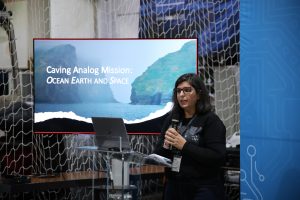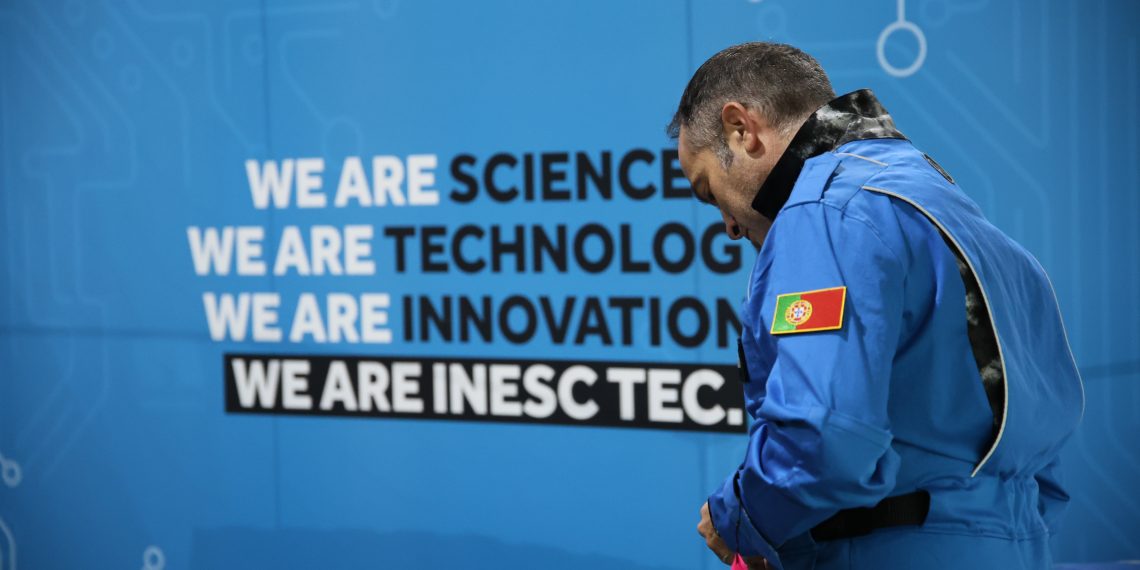From November 22 to 28, a team of seven people from various nationalities will be isolated in Gruta do Natal, Terceira Island (Azores), replicating the lunar environment. During this period, the team will carry out webinars at several schools. The students – aged 3 to 17 years old – can also contribute to the design of the mission’s patch. The goal is to bring younger people closer to the scientific domains.
The first analog mission carried out in Portugal features several innovative aspects. “We want to pave the way”, explained Ana Pires, mission commander and researcher at INESC TEC, stressing that she is part of a “team of researchers and scientists who believe that only with this type of projects and missions is it possible to create possibilities and opportunities for new generations”.
With eyes set on the future, the mission kicks off on November 22. Promoted by Associação Os Montanheiros and INESC TEC – Institute for Systems and Computer Engineering, Technology and Science, the CAMões Project – Caving Analog Mission for Ocean, Earth and Space Exploration – is not limited to astronauts’ training.
The project stands out for its multidisciplinary approach and the way it fosters scientific and technological development, but also for the commitment to diversity, multidisciplinarity and equity as “education tools”. Ana Pires joins Yvette Gonzalez of Plymouth University as leaders of the mission. An intentional choice focused on inspiring future generations of scientists and engineers.
In close collaboration with Ciência Viva, the project features an educational component, with the promotion of webinars targeting schools in mainland Portugal, Madeira, the Azores, the United States of America, Puerto Rico, Indonesia, and South Africa – granting students the opportunity to closely follow the mission and ask questions to the team. The students – ranging from 3 to 17 years old – will also have the chance to participate in a competition to design the mission patch.
Ana Noronha, Executive Director of Ciência Viva explained that the goal is to “create an educational mission around the real endeavour”, to educate and engage with younger people, raising their awareness of Science, Technology, Engineering and Mathematics. “The CAMões mission is very rich in terms of scientific learning, discovery, and exploration; we think it could be an interesting challenge to schools”, she said. The goal is to familiarise students and teachers with the themes related to the project, representing the CAMões mission team in their regions and developing small works and tasks related to the experiences that the mission will carry out.

A Gruta do Natal and technology
“With this mission, we seek to put Terceira Island, the region of the Azores and Portugal, on the map of similar missions!”, highlighted Ana Pires, remembering that this project allows the exploration of technologies with the objective of integrating space, land, and sea – with significant benefits to local communities and scientific research. “The idea is to test underwater technologies, robots, sensors that can solve problems on land, and explore new marine species – taking advantage of the climate ecosystem, and the island’s geodiversity and biodiversity. It is a much more comprehensive project than astronauts’ training”, she stated.
Multidisciplinary collaboration and scientific innovation are vital to the project, something that is also present in the suits developed for the team – created with smart textiles that provide extra comfort to carry out tasks in extreme environments.
Using technology developed by Sabrina Thompson, a NASA member for more than 10 years and founder of GIRL IN SPACE CLUB (a company dedicated to fashion and STEAM education), the new flight and caving suits represent the perfect match between art, fashion and design, creating revolutionary solutions to the challenges faced by women in extreme environments. Innovation in technology, and in functionality. The suits stand out for their rear opening, a significant milestone, especially for women involved in space missions.
These suits, developed exclusively for the mission, will serve as uniforms, and allow the team to perform their tasks without facing the discomfort of traditional suits – either due to the material or the lack of adequate protection. As a complement, the team will also use t-shirts with temperature regulation technology and leggings that – in addition to their compressive qualities – have a coating to prevent muscle fatigue, developed by the Portuguese Filipa Fernandes (from the company OozeNanotech).
After the mission, SPRINGER NATURE will publish a book dedicated to the CAMões endeavour and the volcanic structures (in 2024 or 2025). The objective is to highlight the importance of the science and technology involved, but also to publish the main results of the mission.
Learn more about the project and meet the team here.




 News, current topics, curiosities and so much more about INESC TEC and its community!
News, current topics, curiosities and so much more about INESC TEC and its community!